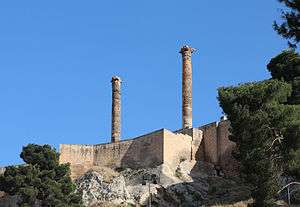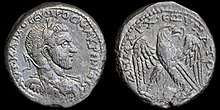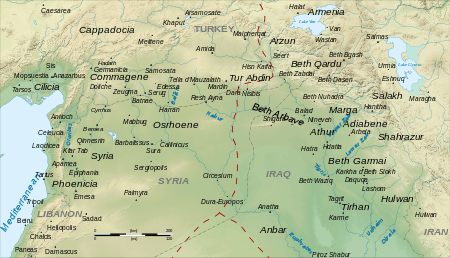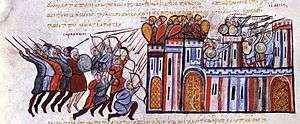Edessa

Edessa (Ancient Greek: Ἔδεσσα; Arabic: الرها ar-Ruhā; Turkish: Şanlıurfa; Kurdish: Riha) was a city in Upper Mesopotamia, founded on an earlier site by Seleucus I Nicator ca. 302 BC. It was also known as Antiochia on the Callirhoe from the 2nd century BC. It was the capital of the semi-independent kingdom of Osroene from c. 132 BC and fell under direct Roman rule in ca. 242. It became an important early centre of Syriac Christianity. It fell to the Muslim conquest in 638, was briefly retaken by Byzantium in 1031 and became the center of the Crusader state of the County of Edessa from 1098–1144. It fell to the Turkic Zengid dynasty in 1144 and was eventually absorbed by the Ottoman Empire in 1517. The modern name of the city is Urfa and it is located in Şanlıurfa Province in the Southeast Anatolia Region of Turkey.
Names
The earliest name of the city was Admaʾ (Aramaic: אדמא, also written Adme, Admi, Admum) recorded in Assyrian cuneiform in the seventh century BC.[1] A Hellenistic settlement was founded on the location of the Syrian town by Seleucus I Nicator in 304 BC, named Edessa after the ancient capital of Macedonia, perhaps due to its abundant water, just like its Macedonian eponym.
It was renamed Callirrhoe or Antiochia on the Callirhoe (Ἀντιόχεια ἡ ἐπὶ Καλλιρρόης) in the 2nd century BC (found on Edessan coins struck by Antiochus IV Epiphanes, r. 175–164 BC).[2] This same name appears also as Armenian: Ուռհա, transliterated Urha or Ourha, in Syriac as Orhay (ܐܘܪܗܝ), and in Arabic as الرُّهَا ar-Ruha, and Riha the Kurdish languages, Latinized as Rohais, and finally adopted in Turkish as Urfa or Şanlıurfa ("Glorious Urfa"), its present name. It was named Justinopolis in the early 6th century.
According to Jewish and Muslim traditions, it is Ur of the Chaldees, the birthplace of Abraham.
History
Early history
In the second half of the second century BC, as the Seleucid Empire disintegrated durings wars with Parthia (145–129BC), Edessa became the capital of the Abgar dynasty, who founded the kingdom of Osroene (also known as Edessa). This kingdom was established by Arabs from the northern Arabian Peninsula and lasted nearly four centuries (c. 132 BC to 214), under twenty-eight rulers, who sometimes called themselves "king" on their coinage. Edessa was at first more or less under the protectorate of the Parthians, then of Tigranes of Armenia, Edessa was Armenian Mesopotamia's capital city, then from the time of Pompey under the Roman Empire. Following its capture and sack by Trajan, the Romans even occupied Edessa from 116 to 118, although its sympathies towards the Parthians led to Lucius Verus pillaging the city later in the 2nd century. From 212 to 214 the kingdom was a Roman province.

The Roman emperor Caracalla was assassinated on the road from Edessa to Carrhae (now Harran) by one of his guards in 217. Edessa became one of the frontier cities of the province of Osroene and lay close to the border of the Sasanian Empire. The Battle of Edessa took place between the Roman armies under the command of Emperor Valerianus and the Sasanian forces under Emperor Shapur I in 260. The Roman army was defeated and captured in its entirety by the Persian forces, including Valerian himself, an event which had never previously happened.
The literary language of the tribes that had founded this kingdom was Aramaic, from which Syriac developed. Traces of Hellenistic culture were soon overwhelmed in Edessa, which employed Syriac legends on coinage, with the exception of the client king Abgar IX (179–214), and there is a corresponding lack of Greek public inscriptions.[3]
Early Christian centre


The precise date of the introduction of Christianity into Edessa is not known. However, there is no doubt that even before AD 190 Christianity had spread vigorously within Edessa and its surroundings and that shortly after the royal house joined the church.[4]
According to a legend first reported by Eusebius in the fourth century, King Abgar V was converted by Thaddeus of Edessa,[5] who was one of the seventy-two disciples, sent to him by "Judas, who is also called Thomas".[6] However, various sources confirm that the Abgar who embraced the Christian faith was Abgar IX.[7][8][9] Under him Christianity became the official religion of the kingdom.[10]
He was succeeded by Aggai, then by Saint Mari, who was ordained about 200 by Serapion of Antioch. Thence came to us in the second century the famous Peshitta, or Syriac translation of the Old Testament; also Tatian's Diatessaron, which was compiled about 172 and in common use until Rabbula, Bishop of Edessa (412–435), forbade its use. Among the illustrious disciples of the School of Edessa, Bardaisan (154–222), a schoolfellow of Abgar IX, deserves special mention for his role in creating Christian religious poetry, and whose teaching was continued by his son Harmonius and his disciples.
A Christian council was held at Edessa as early as 197.[11] In 201 the city was devastated by a great flood, and the Christian church was destroyed.[12] In 232 the relics of the apostle Thomas were brought from Mylapore, India, on which occasion his Syriac Acts were written. Under Roman domination many martyrs suffered at Edessa: Sharbel and Barsamya, under Decius; Sts. Gûrja, Shâmôna, Habib, and others under Diocletian. In the meanwhile Christian priests from Edessa had evangelized Eastern Mesopotamia and Persia, and established the first Churches in the Sasanian Empire. Atillâtiâ, Bishop of Edessa, assisted at the First Council of Nicaea (325). The Peregrinatio Silviae (or Etheriae)[13] gives an account of the many sanctuaries at Edessa about 388.
Byzantine period
Under Byzantine rule, as metropolis of Osroene, Edessa had eleven suffragan sees.[14] Michel Le Quien mentions thirty-five bishops of Edessa, but his list is incomplete.[15]
The Eastern Orthodox episcopate seems to have disappeared after the 11th century. Of its Jacobite bishops, twenty-nine are mentioned by Le Quien (II, 1429 sqq.), many others in the Revue de l'Orient chrétien (VI, 195), some in Zeitschrift der deutschen morgenländischen Gesellschaft (1899), 261 sqq. Moreover, Nestorian bishops are said to have resided at Edessa as early as the 6th century.
When Nusaybin was ceded to the Persians in 363, Ephrem the Syrian left his native town for Edessa, where he founded the celebrated School of the Persians. This school, largely attended by the Christian youth of Persia, and closely watched by Rabbula, the friend of Cyril of Alexandria, on account of its Nestorian tendencies, reached its highest development under Bishop Ibas, famous through the Three-Chapter Controversy, was temporarily closed in 457, and finally in 489, by command of Emperor Zeno and Bishop Cyrus, when the teachers and students of the School of Edessa repaired to Nisibis and became the founders and chief writers of the Nestorian Church in Persia.[16] Miaphysitism prospered at Edessa, even after the Arab conquest.
Edessa was rebuilt by Justin I (r. 518–527), and called after him Justinopolis.[17]
The city was taken in 609 by the Sasanian Empire, and soon retaken by Heraclius, but lost to the Muslim army under the Rashidun Caliphate during the Muslim conquest of the Levant in 638.
Arab rule
The Armenian chronicler Sebeos, Bishop of Bagratid Armenia writing in the 660s, gives the earliest narrative accounts of Islam in any language today. Sebeos writes of a Jewish delegation going to an Arab city (possibly Medina) after the Byzantines conquered Edessa:
Twelve peoples [representing] all the tribes of the Jews assembled at the city of Edessa. When they saw that the Iranian troops had departed ... Thus Heraclius, emperor of the Byzantines, gave the order to besiege it. (625) ... So they departed, taking the road through the desert to Tachkastan to the sons of Ishmael. [The Jews] called [the Arabs] to their aid and familiarized them with the relationship they had through the books of the [Old] Testament. Although [the Arabs] were convinced of their close relationship, they were unable to get a consensus from their multitude, for they were divided from each other by religion. In that period a certain one of them, a man of the sons of Ishmael named Mahmet, a merchant, became prominent. A sermon about the Way of Truth, supposedly at God's command, was revealed to them... he ordered them all to assemble together and to unite in faith... He said: "God promised that country to Abraham and to his son after him, for eternity. And what had been promised was fulfilled during that time when [God] loved Israel. Now, however, you are the sons of Abraham, and God shall fulfill the promise made to Abraham and his son on you. Only love the God of Abraham, and go and take the country which God gave to your father, Abraham. No one can successfully resist you in war, since God is with you.
Muslim tradition tells of a similar account, known as the second pledge at al-Aqabah. Sebeos' account suggests that Muhammad was actually leading a joint venture toward Palestine, instead of a Jewish-Arab alliance against the Meccan pagans toward the south.
The Byzantines often tried to retake Edessa, especially under Romanos I Lekapenos, who obtained from the inhabitants the "Image of Edessa", an ancient portrait of Christ, and solemnly transferred it to Constantinople, August 16, 944. This was the final great achievement of Romanus's reign. This venerable and famous image, which was certainly at Edessa in 544, and of which there is an ancient copy in the Vatican Library, was looted and brought to the West by the Republic of Venice in 1207 following the Fourth Crusade. The city was ruled shortly thereafter by Marwanids.
Later medieval history

In 1031 Edessa was given up to the Byzantines under George Maniakes by its Arab governor. It was retaken by the Arabs, and then successively held by the Greeks, the Armenians, the Seljuq dynasty (1087), the Crusaders (1099), who established there the County of Edessa and kept the city until 1144, when it was again captured by Imad ad-Din Zengi, and most of its inhabitants were allegedly slaughtered together with the Latin archbishop (see Siege of Edessa).[18] These events are known to us chiefly through the Armenian historian Matthew, who had been born at Edessa. In 1144 the city had an Armenian population of 47,000.
Since the 12th century, the city has successively been ruled by the Sultans of Aleppo (the Ayyubid dynasty), Sultanate of Rum, the Mongols, the Mamluks, the Aq Qoyunlu, the Safavid dynasty, and from 1517 to 1918 the Ottoman Empire.[19]
In 1890, the population of Edessa consisted of 55,000, of which the Muslim population made up 40,835.[19]
Syriac literature
The oldest known dated Syriac manuscripts (AD 411 and 462), containing Greek patristic texts, come from Edessa.
Following are some of the famous individuals connected with Edessa:
- Jacob Baradaeus, an ardent Miaphysite who preserved the (Oriental) Orthodox church after the persecution subsequent to the Chalcedonian controversy Jacobites
- Jacob, Bishop of Edessa, a prolific writer (d. 708);
- Theophilus, a Maronite an astronomer, who translated into Syriac verse Homer's Iliad and Odyssey;
- Stephen Bar Sudaïli, monk and pantheist, to whom was owing, in Palestine, the last crisis of Origenism in the 6th century
- The anonymous author of the Chronicon Edessenum (Chronicle of Edessa), compiled in 540
- The anonymous writer of the story of "The Man of God", in the 5th century, which gave rise to the legend of St. Alexius, also known as Alexius of Rome (because exiled Eastern monks brought his cult and bones to Rome in the 10th century).
See also
- Image of Edessa
- Knanaya
- List of bishops of Edessa
- Category:Ancient Assyrian cities
- Matthew of Edessa
Notes
- ↑ Harrak 1992, pp. 212
- ↑ Harrak 1992, pp. 211
- ↑ Bauer, Walter (1991) [1934]. "1. Edessa". Orthodoxy and Heresy in Earliest Christianity. U Penn.
- ↑ von Harnack, Adolph (1905). The Expansion of Christianity in the First Three Centuries. Williams & Norgate. p. 293.
there is no doubt that even before AD 190 Christianity had spread vigorously within Edessa and its surroundings and that (shortly after 201 or even earlier?) the royal house joined the church
- ↑ Herbermann, Charles George (1913). The Catholic Encyclopedia. Encyclopedia Press. p. 282.
- ↑ {Eusebius Pamphilius: Church History, Life of Constantine, Oration in Praise of Constantine, Book 1 Chapter 13 http://www.ccel.org/ccel/schaff/npnf201.iii.vi.xiii.html}
- ↑ Cheetham, Samuel (1905). A History of the Christian Church During the First Six Centuries. Macmillan and Company. p. 58.
- ↑ von Gutschmid, A. (July 1887). "Untersuchungen über die Geschichte des Königliches Osroëne" [Studies on the history of Royal Osroene]. Mémoires de l'Académie Impériale des Sciences de Saint-Pétersbourg (in German). Saint Petersburg. 35.
- ↑ Shahid, Irfan (1984). Rome and the Arabs. Dumbarton Oaks. pp. 109–12.
- ↑ Lockyer, Herbert (1988). All the Apostles of the Bible. Zondervan. p. 260. ISBN 0-310-28011-7.
- ↑ Eusebius of Caesarea, Historia ecclesiastica, V, 23.
- ↑ Chronicon Edessenum, ad. an. 201.
- ↑ Ed. Gian Francesco Gamurrini, Rome, 1887, 62 sqq.
- ↑ Echos d'Orient, 1907, 145.
- ↑ Oriens christianus II, 953 sqq.
- ↑ Labourt, Le christianisme dans l'empire perse, Paris, 1904, 130–41.
- ↑ Evagrius, Hist. Eccl., IV, viii
- ↑ El-Azhari 2016, p. 91.
- 1 2 al-Ruha, Suraiya Faroqhi, The Encyclopaedia of Islam, Vol. VIII, ed. C.E.Bosworth, E. van Donzel, W.P. Heinrichs, G. Lecomte, (Brill, 1995), 591-593.
References
- Harrak, A (1992), "The Ancient Name of Edessa" (PDF), Journal of Near Eastern Studies, 51 (3): 209–214, doi:10.1086/373553
- El-Azhari, Taef (2016). Zengi and the Muslim Response to the Crusades: The Politics of Jihad. Routledge.
Further reading
- Walter Bauer 1971. Orthodoxy and Heresy in Earliest Christianity, 1934, (in English 1971): Chapter 1 "Edessa" (On-line text)
- A. von Gutschmid, Untersuchungen über die Geschichte des Königliches Osroëne, in series Mémoires de l'Académie Impériale des Sciences de Saint-Pétersbourg, series 7, vol. 35.1 (St. Petersburg, 1887)
- J. B. Segal, Edessa: The Blessed City (Oxford and New York: University Press, 1970)
- Schulz, Mathias, "Wegweiser ins Paradies," Der Spiegel 2372006, Pp. 158–170.
- This entry uses text from the Catholic Encyclopedia, 1909.
External links
- Old and new Images from Edessa
- Richard Stillwell, ed. Princeton Encyclopedia of Classical Sites, 1976: "Antioch by the Callirhoe, later Justinopolis (Edessa; Urfa) Turkey"
- Andre Palmer, in e-journal Golden horn: Journal of Byzantium An essay on Egeria's escorted visit (April 384), and the bishop's tall tales
- Chronicle of Edessa
- Ancient Coins of Edessa at wildwinds.com
- Livius.org: Edessa
Coordinates: 37°09′N 38°48′E / 37.150°N 38.800°E
| Wikimedia Commons has media related to Şanlıurfa. |